You have no items in your cart. Want to get some nice things?
Go shopping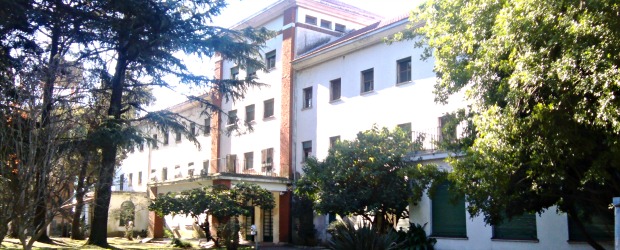
It is perhaps telling of my own squeamishness that in the decade or so that I have been travelling to Buenos Aires my visit to ESMA this August should have been my first. The former School of Naval Mechanics, which doubled as one of the most active clandestine centres during the military government, is synonymous for many with the torture and murder that took place between 1976 and 1983. It isn’t far from my usual stomping ground of Belgrano. I have passed it many times on Avenida Del Libertador, often when travelling by taxi to the airport, or by bus to the Northern suburb of Vincente López. It often seemed, as I gazed out at this compound of orderly military barracks, that people were looking the other way, denying the existence of this uncomfortable reminder of Argentina’s troubled past. On my map of Buenos Aires, published in 2003, the military compound, unlike the other military bases in the city, is left unlabelled, indicated only by a blank grey space.
‘Well you know what happened there.’ I’ve forgotten who said these words. This was several years ago, in 2007 or 2009. We’d been to the riverfront park in Vincente López, where porteños go on weekends to ride bikes, throw Frisbees, or visit one of the many bars and restaurants that line the promenade. Walking back to catch the bus we took a road that runs past the perimeter of the ESMA compound. The torture and murder had taken place right there, hidden in plain view. ‘They’ve been turning it into some sort museum,’ somebody had said with a roll of their eyes.
Feelings about the events that took place during the military dictatorship run deep. These events occurred within living memory for many and the fallout from them is still being felt. Many of the generals who held power during the 70s and 80s have only recently been brought to justice. During my recent trip one of the babies secretly adopted from pregnant detainees, now a man in his thirties, was indentified and reunited with his genetic grandmother, one of the leaders in the campaign for truth regarding the disappearances. To mention ESMA is to walk a potential minefield of emotion. People might change the conversation or abruptly leave the room. So, better not mention it at all? Better to leave it off the maps and to look the other way?
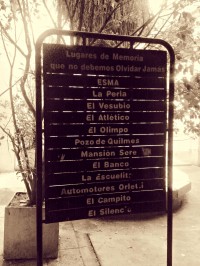
The photographer and artist Marcelo Brodsky didn’t think so. ‘Places of memory that we should never forget’. So reads the inscription in his photograph, Los Campos II (2001). The photograph is of a sign, his installation, listing the names of a dozen of the six hundred clandestine centres of detention, torture, and murder used by the Argentine military government. The list begins with ESMA, where of the 5000 men and women who were detained and tortured there, only 150 survived. Brodsky, whose brother was disappeared by the military, placed the sign opposite ESMA and photographed it to raise awareness of the importance of remembering what had happened there. It was made to resemble the Wittenberg Platz Memorial in Berlin, which Brodsky also photographed, titling the image Los Campos I. The original memorial lists the names of the Nazi concentration camps and the Jewish ghettos. Brodsky’s photographs deliberately and provocatively invited a comparison between the way the memory of the holocaust was being handled in Germany and the way the memory of the disappeared of was being handled in Argentina. If there was a Jewish Museum in Berlin, why wasn’t there a similar space dedicated to memory in Buenos Aires?
The seventeen hectare site which once formed ESMA is now the Space for Memory and Human Rights (Espacio Memoria Y Derechos Humanos), having been appropriated from the navy for this new use in 2004. In Austerlitz, WG Sebald’s narrator describes his sensations upon entering the fortress of Breendonk, a Belgian fortification which has been used by the SS as a place of imprisonment, forced labour, interrogation and execution. On approaching ESMA I was somehow expecting to share something of that narrator’s sense of how ‘with every step forward the air was growing thinner and the weight above me heavier.’ Memorials to those who were murdered and ‘disappeared’ at ESMA were evident even before we entered and the perimeter fence to the compound was adorned with large placards explaining the purpose and history of the museum. However, upon entering I was struck by the pleasant leafiness and how the noise of the traffic on the busy Avenida del Libertador fell away. Unlike Sebald in Breendonk, I found it difficult to believe that anything bad had happened here.
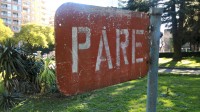
The paths led through tidy lawns and orderly buildings, a series of barracks and administration blocks which mostly date from the 1930s. One of these buildings houses the Haroldo Conti Arts Centre (Centro Cultural Memoria Harold Conti), so named after a writer who was arrested in 1976 and later recorded as ‘disappeared’. The centre contains exhibitions of art and photography, a small cinema, a library, as well as a cafe and bookshop. It is a building that echoes with voices and footsteps, the clatter of cutlery in the cafeteria. Echoes. Memory is a kind of echo, a reverberation from the past, a ripple on the surface of the present. Cultural memory needs to hold onto and preserve echoes, so that others can hear them and learn from them. This building is a place of such echoes. The auditorium holds a permanent exhibit, Ideological Cars (Autores Ideologicos), which consists of a disassembled Ford Falcon, the car used by secret police during military rule, painted white and suspended in mid-air, so that viewers can walk through it, examine the springs of the back seats into which people would have been bundled at gun point. It is an evocative piece, alert to the symbolic power of this innocuous looking family car which became simultaneously an icon of middle class aspiration and of state repression. Ford Falcons also featured in the photographic exhibition by Fernando Gutiérrez, ‘Photography and Memory’, whose work is tuned in to the connotative power of places and objects. In his photographic sequence Thirty Thousand (Treintamil) the images, of wrecked cars and remote roads, of barbed wire and bricked up windows, of old aeroplanes and the River Plate, of empty shoes and bouquets of flowers, speak powerfully of arrest, detention, murder, and loss. Another sequence, Things from the River (Cosas Del Río), portrays objects washed up on the banks of the River Plate, a passport, a shoe, a crayon, half a pair of spectacles, a rusty nail, a piece of leather, a fragment of wrapper from a packet of crackers, as if in evidence of those whose bodies were ‘disappeared’ into the waters of the river and the ocean. These images are also part of the aftermath, the echoes of the events themselves. What is the visual equivalent of an echo? A reflection? These images are like reflections on the rippled waters of memory. They brought to mind Austerlitz, the eponymous hero of Sebald’s novel, and of his search for his pre-kindertransport self, for his memories repressed by trauma, in the places of his forgotten infancy. Guitérrez’s images seemed to me a similar search, the use of reflections of places and objects a way of coming to terms with the source of the ripples.
Outside again, I became acutely aware of sound. The calls and squabbles of the benteveo birds and parakeets in the trees, the traffic on Libertador, the same sounds that those being held captive must have heard. I passed a long building, the windows of which had been filled with images of the thousands who perished. It was quiet and peaceful. This disparity between ease and unease created an odd tension. I came to one of the concrete pill boxes that were positioned around the buildings that held the detainees, and walked the length of a high wall built to shield from public view the unloading of human cargo from the Ford Falcons. And yet, buildings must have overlooked this place. Some of the flats opposite the compound look to date from the late 1970s. Could people really have known nothing? Were there mutterings? Rumours of comings and goings? Or was it such a terrible reality that people chose not to perceive it in their midst? A friend recalled going to see the world cup final of 1978 at ESMA on a big TV, having been invited by a school friend whose father was a naval officer. It is unsettling to think that they might have been a matter of yards from the detained prisoners, who it is said could hear the roar of the crowd coming from the River Plate Monumental Stadium, less than a mile away. Two realities kept apart. It is akin to the compartmentalization that takes place in the mind of a psychopath. The criminal side of the mind is hidden behind a more personable persona. Torture and murder hidden, whilst families watched the football. A concentration camp in the shadow of a world cup stadium. The detention centre was hidden in plain sight. The officers’ mess which housed the torture rooms and cells remained in use as an officers’ mess. Total compartmentalization.
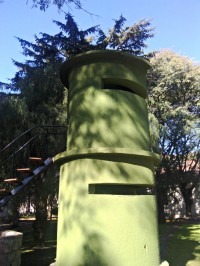
The officers’ mess is an imposing building, three stories high, with a central block rising up another story, and wings surrounding two courtyards at the rear. Its windows are grilled. There were tours of the attic rooms where the prisoners were held captive and interrogated, but I had seen enough of such things for one day. My wife and daughters were waiting for me not far away at a celebration for Children’s Day being held at one of the other cultural centres on the compound, ECUNHI (Espacio Cultural Nuestros Hijos), which was funded by the Asociación Madres de Plaza de Mayo, a group of women who for years set up camp in the centre of Buenos Aires demanding truth and justice for their disappeared children. I discovered the celebrations in full swing. There was a show going on outside. Families were seated around it, the parents sharing maté, the green tea that is such a vital part of Argentine identity, their children leaning forwards, intent on the performance. A number of stalls offered the sort of games one might find at an English village fete—a hoopla, a cocaanut shy. Clowns were clowning around. There were art activities and music. My daughters were enjoying themselves, both completely unaware of the former purpose of the place, of its history. In time they will learn, but it seemed fitting that new memories were being established, that their first associations of this place would be happy ones. To reclaim such a place, what Sebald might have described as ‘a macabre place’ like Breendonk, is only the first step towards this country reconciling itself to its past. The next step surely comes in an event like the Children’s Day celebration, which looks fully to the future, to a generation who might learn not to repeat past mistakes.
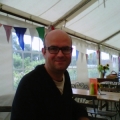
About Iain Robinson
Iain Robinson is an academic and writer living in the East of England. His debut novel The Buyer is published by CoLiCo Press. He has recently had articles published on novels by Sarah Hall and Will Self. Iain is currently represented by Litro's bespoke literary agency, Litro Represents.



